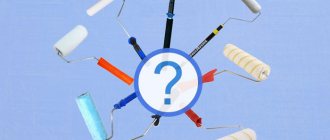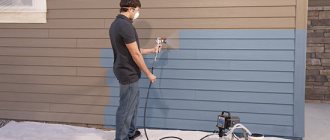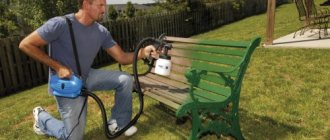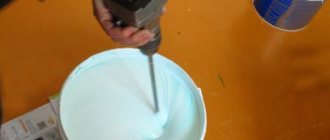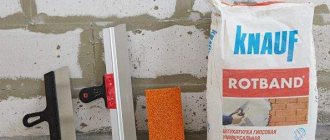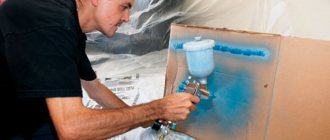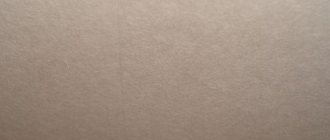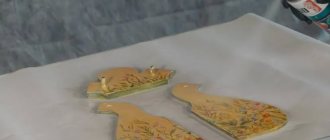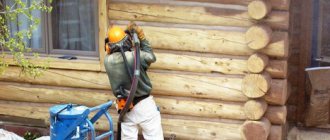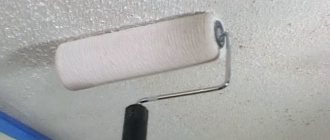Basics
Before priming begins, glass and windows are covered with special films. You can also use regular newspapers. Rust is removed from the car, otherwise the material will not dry out. You also need to get rid of any dust and dirt on the car.
Applying the first layer
It is important to find out whether the composition contains a hardener. If this component is present, the primer will dry in half an hour. Without him - a day. Movements of the hand with the gun should be smooth, without jerking or stopping. Then the layer will be uniform.
Painting with a spray gun
Priming procedure
The operation takes place in several stages:
Painting on metal and rust
Attention! Novbytkhim 3 in 1 paint is not suitable for application on surfaces previously painted with nitro-based products (NC), since the coating swells.
The composition is thoroughly mixed before use. Aerosol primer enamel 3 in 1 for rust? For work use a brush, roller or spray.
When applied by spraying, the primer-enamel is diluted to the required degree of viscosity with water, but not more than 5% of the total volume.
Paint for metal and rust has good covering power, its consumption is approximately 12 m2/l per layer. To obtain a high-quality coating, it is recommended to apply two layers of the product.
The interlayer drying time is 1 hour; for the composition to dry completely, you must wait 2 hours.
Pentaphthalic, oil and vinyl chloride based paints and enamels, as well as water-dispersion paints, can be applied over the finished coating.
Solvents and thinners. What is the difference?
Materials
The terms "solvent" and "diluent" are often confused, but in reality they are different materials and their mechanism of action is not the same. Let's try to figure out what the difference is, and at the same time find out which materials are best used for diluting paintwork materials and what the savings on these materials entail.
How is it recommended to dilute acrylic paints?
For these purposes, special substances are used. Their use is justified if it is required:
- reducing the viscosity of the composition for more convenient use when working with special tools for applying paint;
- selection of the required thickness of the coating layer to be created and the speed at which the paint will dry;
- returning the original structure of the coloring matter.
The thinner does not interact with the film-forming components of the paint, but only slightly dilutes it. The substance added to the acrylic base evaporates from the applied paint after it dries.
Why do you need to prime the surface?
- Subsequent finishing materials are placed on a primed surface with better quality.
- The primer extends the service life of the coating.
- A deeply penetrating primer mass can regulate the porosity of the base and strengthen it.
- After penetration, the primer prevents wear of the material and protects against corrosion.
- Masking of minor defects.
- Primer mixtures for painting, puttying, and varnishing significantly reduce the consumption of finishing materials.
Study of samples
GF-021
This is a carmine or gray primer based on glyphthalic varnish. Thinner – solvent; It is permissible to use a mixture of white spirit with acetone or turpentine in a 1:1 ratio.
Heat resistance is limited to +60C. The primer provides anti-corrosion protection and can be used as an independent coating. Compatible paints - alkyd and oil.
The technical characteristics of the primer for metal are quite ordinary:
- Mass fraction of non-volatile substances – 54-60%.
- Drying time for one layer “touch-to-touch” is 12 hours.
- Resistance to static effects of table salt solution – 24 hours, mineral oil – 48 hours.
In the photo - GF-021, the most common primer for metal.
GF-031
This heat-resistant primer for metal can be used at temperatures up to 200C. It is compatible with steel, aluminum and magnesium bases; used under enamels of the PF, GF, FL and EF series.
The material provides reliable protection against corrosion, is chemically resistant and, among other things, is used in civil aviation.
- Yellow color.
- Drying takes 2.5 hours at a temperature of +100C.
- Base – glyphthalic varnish; Solvent, xylene, RKB-1 and RS-2 solvents can be used as diluents.
The average price in Russian retail is about 100 rubles.
GF-031 is used as a base coat for painting civil airliners.
Acid primer for metal differs from most other compositions in that it does not simply stick to the base: the orthophosphoric acid included in VL-02 partially destroys the metal and transforms it, forming a persistent film of phosphate compounds.
The base of the soil is polyvinbutyral; For dilution, toluene, xylene, solvents R-6, 648 and RFG can be used.
- VL-02 is one of the fastest drying compounds. One layer dries at a temperature of +20C for no more than 15 minutes.
- It is used for almost any paint based on organic solvents. Here is an incomplete list of compatible enamels: UR, HS, HV, AK, NTs, ML, MS, MA, GF, PF, EP, AU, AS.
- VL-02 is an ideal primer for galvanized metal, aluminum and stainless steel, providing high-quality adhesion even without preliminary rough grinding.
VL-02 is mixed with an acid diluent immediately before use.
Certificate of conformity
The certificate of conformity is direct evidence that during production the manufacturing company adhered to all the necessary norms and rules that were specified by current legislation. When purchasing GF 021 primer, the seller must provide this certificate upon the buyer’s first request. If such documentation is not available, it is better to refuse to purchase such products, because they may be of very poor quality.
Primer GF 021 is a fairly popular material, which, if used correctly, will significantly improve the characteristics of the treated surface. The main thing is to store the product correctly and follow the application technology so that the primer performs as well as possible.
How to dilute primer for car painting
Regardless of the composition, the liquid must be thoroughly mixed and all components raised. This is the primary preparation, after which you can add the native hardener and solvent to the soil. It is not advisable to use other brands that are less compatible and effective.
The proportions are indicated on the jars. It is not recommended to carry out mixing without a container with measuring divisions - a procedure performed by eye will cause poor painting.
The resulting mixture is passed through a special filter, which is sold in the store. If you don’t have a device, you can use regular gauze, but the liquid will have to be poured 4-5 times.
Primer for cars and dilution features
There are two types of substances in stores. Brands are distinguished by composition, manufacturer and price:
- primary or main - used for processing metal that is most susceptible to corrosion;
- secondary or filler - needed to fill and align parts.
The first type should dry well after application. If you immediately apply a second one, then some components (acids) will not have time to react and harden. Undried particles will remain under the next layer and will not create the necessary protection. Therefore, you need to leave the soil for 30 minutes.
Working with a spray gun
For better results, filler is placed on top of the primary layer. Experts do not recommend applying too much of the substance. They take a long time to dry and form a jelly-like substance that may not harden at all.
These soils do not have any specific cultivation requirements; you just need to follow the attached instructions. Sometimes car enthusiasts encounter problems when trying to dilute acrylic primer.
How to divorce
This subtype of filler is necessary to fill pores and eliminate unevenness on the surface of the vehicle. Soil contains many components. The difference depends on the manufacturer. Therefore, for each option you need to select the right thinner, otherwise it will not be possible to dilute the primer for painting a car with a spray gun.
It is advisable to use two liquids:
- Water is used exclusively in situations where the component of the material itself is a water-acrylic composition. If the primer is old and hardened, the liquid must be boiled.
- Acrylic thinner is a special substance for thinning. Use the same brand as the primer.
It is prohibited to use solvents 647 and 650 for dilution - these types are incompatible with acrylic. For such purposes, if there is no water or thinner, substance 646 is used.
You can dilute the primer for painting a car with a spray gun in a ratio of 4:1 with the addition of liquid. Just read the label for the exact information. The acrylic composition will be in working condition within 60 minutes. It is during this period that you need to have time to mix the liquids and apply them to the car. For this operation, it is advisable to use a spray gun to prime the car, and pre-filter the composition.
Preparing the premises
It is forbidden to work with the machine in an open space - dust and dirt will certainly stick to the body. The scorching sun also negatively affects the soil.
You need to work in a sterile room, it is advisable to spray the walls and floor with water immediately before applying the primer. Ventilation is important - liquid vapors are harmful to humans. The appearance of a draft must be excluded - otherwise the layer will be applied unevenly.
There should be a lot of light in the garage - otherwise you may notice defects on the treated surface when the car is illuminated outside in daylight.
Set of tools and consumables
The following equipment is used for the operation:
- Pneumatic spray gun for priming cars - for uniform spraying. You should not skimp on this tool - the better the quality of the remote control, the better the result.
- Machine for processing dried soil. You can do the sanding by hand, but it will take a lot of time, and the quality of the work will suffer.
- Alcohol - before applying the primer, the car must be thoroughly degreased, otherwise the layer will not be fixed so securely.
- Sandpaper - you can use P-800 or P1200.
- Primer. You need to choose depending on the color of the vehicle and the paint that will be used in the future.
Treating a car with a spray gun
It is advisable to have a rag on hand - when working with the material, sometimes you need to wash off excess mass.
Preparation
Before pouring into the primer spray gun for cars, the composition is mixed until a homogeneous consistency. Add as much hardener as indicated on the package - otherwise the mixture will be of poor quality. You should not mix the component with the entire primer, since the material is applied in several stages. If you combine the components in advance, the liquid will harden ahead of time.
Before use, the primer must be filtered to get rid of large particles. Otherwise, the device will not work well, which will lead to the formation of smudges.
The consistency of the composition must be correct - for measurement, use a device built into the spray gun for priming the car. If the indicator is high, you need to add a solvent.
Procedure
Apply the first layer - you can allow smudges, they will be removed during sanding. The distance of the gun from the car is 25 cm. If there are no additives in the primer, the coating dries for a day.
The initial layer is sanded and you can proceed to the final priming. Leaks are unacceptable. If formed, it is necessary to remove and carry out the procedure again. If defects are identified, an additional layer is applied.
Properties and application of primer enamel
Novbytkhim primer enamel has a very wide range of applications. It can be used for protective and decorative finishing of glossy, matte and rusty metal surfaces. The composition is in demand in everyday life for painting various fences, garages, gates, doors, safes, window grilles, furniture, etc. In addition, it is used to treat bridges, power lines, and agricultural machinery.
Primer enamel is used for painting products that are difficult to clean from rust for some reason: due to large dimensions, complex profile, lack of conditions.
The composition is suitable for treating rusty internal surfaces of cars: underbody, wings, etc. After drying, the enamel forms a coating that is resistant to salt water, mineral oils, as well as sudden temperature changes (withstands operation in the range from –45°C to + 60°C).
Paint for metal and rust is a universal 3-in-1 product; it combines the properties of an anti-corrosion primer, a rust converter and decorative enamel. Another advantage is the fact that the composition is diluted with water, does not have an unpleasant odor and does not emit harmful volatile substances.
The manufacturer does not recommend using enamel primer for finishing heated surfaces that are planned to be used indoors.
Metal products, including those covered with rust, can also be painted without prior priming using Hammerite and Alpina Direkt Auf Rost (Caparol) paints. The problem of finishing and protecting metal is described in more detail in the article How and how to paint metal correctly.
Surface preparation
Remove the flaking coating from previously painted surfaces with a scraper, and then clean them with a steel brush. Contaminated items are washed with a solution of washing powder, rinsed and dried.
Oil and grease stains are removed with a rag soaked in white spirit.
It is also recommended to do a test application of enamel primer on previously painted surfaces. In case of swelling or peeling of the old coating, it is removed with a special remover.
